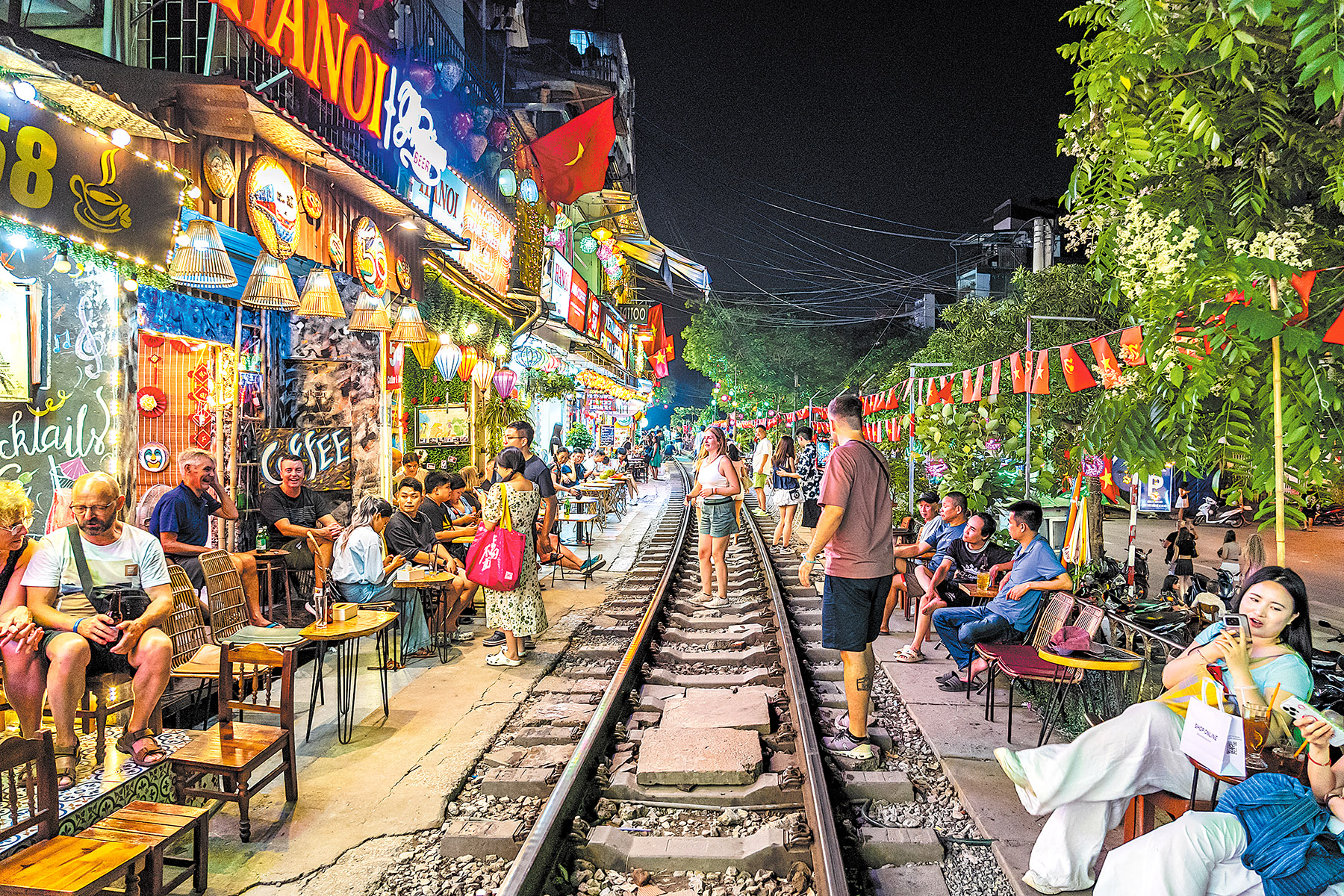Competition intensifies as ASEAN nations vie for foreign visitors

Editor's note: In this weekly feature China Daily gives voice to Asia and its people. The stories presented come mainly from the Asia News Network (ANN), of which China Daily is among its 20 leading titles.
As tourism becomes the fastest way to inject revenue into national economies, countries around the world are competing for international travelers amid a global economic slowdown.
This battle for tourists now involves aggressive visa facilitation, streamlined travel measures, and significant promotional budgets — efforts not merely aimed at enhancing the national image, but at generating tangible economic circulation.
In a startling development, Vietnam welcomed more Chinese tourists than Thailand for the first time in the first quarter of 2025.
While Chinese citizens are still traveling abroad, many are choosing destinations other than Thailand, even as Southeast Asian nations compete with visa-free entry campaigns.
READ MORE: Bangkok like a local
In the first quarter of 2025, 1.6 million Chinese tourists visited Vietnam, compared with just 1.3 million to Thailand.
This shift is notable given that in 2024, the number of Chinese visitors to Vietnam was only half of those arriving in Thailand.
Thailand saw a 24 percent year-on-year drop in Chinese arrivals in the first quarter of 2025, largely due to concerns over safety following the high-profile kidnapping of actor Wang Xing in January.
According to Vietnamese online newspaper VnExpress, analysts cited several factors behind Vietnam's tourism boom: intensified tourism promotion campaigns, geographical advantages, and affordability.
This trend accelerated in May, when Chinese arrivals to Vietnam surpassed those from South Korea for the first time, reaching 357,907 visitors — or nearly 40 percent of all international tourists that month.
It marked the first time since Vietnam's post-COVID reopening in March 2022 that China became its top inbound market.

Proactive strategy
Nguyen Tien Dat, CEO of AZA Travel, credited the surge in Chinese tourists to Vietnam's proactive "tourism diplomacy" strategy.
The Vietnam National Authority of Tourism has launched targeted campaigns in China and increased direct flights, such as VietJet's new Ho Chi Minh City-Xi'an route launched on April 29.
Geographically, Vietnam holds an edge as Chinese mainland has only a few swimmable beaches aside from Hainan Island. Chinese tourists, especially those seeking sun and sea, often prefer destinations like Thailand and Vietnam.
Experts suggest Vietnam should focus on attracting high-spending tourists from major cities like Beijing and Shanghai.
Pham Ha, CEO of LuxGroup, a luxury cruise provider, argued that Vietnam should position itself as a premium destination for Chinese travelers by offering high-end shopping, world-class cuisine, access to international luxury brands, and five-star hotel experiences.
Multiple factors have contributed to Vietnam's growing appeal among Chinese tourists.
These include a mutual visa-free travel agreement, province-to-province memorandums of understanding to promote "sister-city" tourism, and the establishment of a cross-border QR code payment system to support seamless financial transactions between the two countries.
Analysts agree China has long been a critical source market for ASEAN tourism, and visa-free access is amplifying the region's appeal.
John Paolo Rivera, an associate director of the Dr Andrew L. Tan Center for Tourism at the Asian Institute of Management in the Philippines, said visa waivers are a major enabler of tourism growth across the region.
Singapore is another country that offers visa-free entry to Chinese nationals. In 2024, Singapore welcomed 16.5 million foreign visitors, with China among the top three source markets. The Singapore Tourism Board expects continued tourism recovery this year, supported by increased flight frequencies.
Yu Hong, a senior research fellow at the East Asian Institute, National University of Singapore, noted that Singapore has long been popular among Chinese tourists due to its geographic proximity, cultural similarities, and a strong network of direct flights linking Singapore with numerous Chinese cities.

Top destination
In the first quarter of 2025, Malaysia surpassed Thailand to become the most-visited country in Southeast Asia, drawing 10.1 million international tourists.
Thailand followed with 9.5 million, Vietnam welcomed 6 million, and Singapore recorded 4 million visitors. Thailand had previously held the regional tourism crown.
According to Travel and Tour World website, Malaysia's rise was fueled by a combination of visa-free entry policies, targeted marketing, and infrastructure upgrades.
The largest number of visitors came from Singapore — 4.9 million tripsfollowed by China and Indonesia, with nearly 1.1 million visits each.
The Malaysian government recently extended its visa-free policy for Chinese tourists by five years, with a potential extension to 2036. Indian tourists are also included in the scheme, which currently runs through 2026. The initiative targets travelers from Asia's two most populous nations.
The report also highlighted the role of improved digital visa systems, enhanced air connectivity, and better coordination between airports and travel agents in delivering a smoother travel experience.
The Hong Leong Investment Bank noted that Malaysia's tourism sector continues to grow despite a sluggish global economy, with Chinese visitor numbers surging 22 percent year-on-year in the first quarter, reaching 10.1 million — making it the highest in Southeast Asia.
This year, Thailand's tourism strategy is focused on survival rather than expansion, as regional competitors accelerate ahead.
Thanapol Cheewarattanaporn, president of the Thai Travel Agents Association, said Thailand's position in the tourism race has become increasingly difficult, especially when compared to countries like Japan and Vietnam.
"While other countries are moving forward, Thailand remains stagnant. The massive Chinese tourist market that once powered our industry has yet to return in full force," Thanapol observed.
Staying afloat
Sisdivachr Cheewarattanaporn, honorary president and senior adviser to the Thai Travel Agents Association, said that urgent stimulus measures are needed to prevent a further decline.
"This year, we must focus on staying afloat. If there are any plans to boost the sector, they must be implemented swiftly to maintain our target of 35 million international arrivals — close to last year's figure," he said.
Thienprasit Chaiyapatranun, president of the Thai Hotels Association, projected foreign arrivals at 34 million this year, below the Tourism Authority of Thailand's official target.
Still, he described this outcome as a solid performance, given softening global demand — particularly from China, where concerns over safety have tarnished Thailand's image.
He urged stronger law enforcement to restore confidence, which would benefit not only Chinese travelers but tourists from other countries as well.
He also called on the government to reconsider its visa waiver program, which currently allows citizens from 93 countries to stay in Thailand for up to 60 days.
ALSO READ: Losing its way
"Visa policies should be tailored to each market in line with travel behavior and average length of stay," he said, noting that some visitors use the scheme to work rather than for leisure.
Suphajee Suthumpun, Group CEO of Dusit Thani, a Thai hospitality company, noted that Thailand now faces fierce competition from alternative destinations across the globe, including Vietnam and the Philippines.
To maintain competitiveness, she urged closer public-private cooperation to extend visitors' length of stay through targeted segments such as medical and wellness tourism, MICE(meetings, incentives, conferences, and exhibitions), gastronomy tourism, long-stay travel, and work-from-anywhere packages.
"As global risks mount, people may be less inclined to travel for leisure alone. But if we adopt a focused marketing approach, we can tap into new demand. The old model of selling Thailand as just a 'pretty destination' no longer works in today's landscape," she said.


